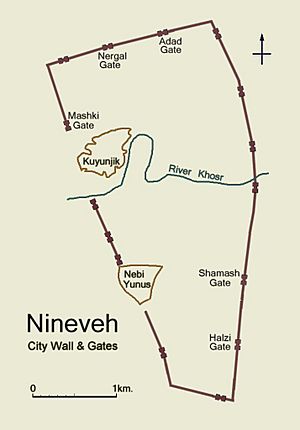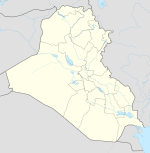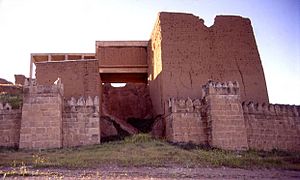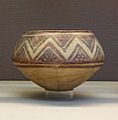Nineveh facts for kids
Quick facts for kids
Nineveh
|
|
|---|---|

Simplified plan of ancient Nineveh showing city wall and location of gateways
|
|
Nineveh was a very old and important city in Assyria, a powerful empire long ago. It was located on the eastern side of the Tigris River. Today, you can find its ruins across the river from the modern city of Mosul in Iraq. Nineveh was once the capital and a major city of the Assyrian empire.
Contents
The Mighty City Walls
The ancient city of Nineveh was protected by huge walls made of stone and mudbrick. These walls were built around 700 BC. They stretched for about 12 kilometers (about 7.5 miles) around the city.
The lower part of the wall was made of strong stone. It had stone towers that stuck out, placed about every 18 meters (about 59 feet). On top of these stone parts, there were three-step parapets, which are like low protective walls.
Important Gateways
The city wall had fifteen very large gateways. These were like checkpoints where people entered and left the city. They probably had places for soldiers to stay, called barracks, and storage for weapons, called armouries.
When their inner and outer doors were closed, these gateways became like small fortresses. Inside the gateways, there were passages and rooms with beautifully cut stone. A stairway from one of these rooms led up to the top of the mudbrick wall.
What Happened to Nineveh's Walls?
Sadly, parts of the city wall were destroyed in February 2015. This happened during an effort by a group called ISIS to damage historical buildings and monuments in the area.
Images for kids
-
Artist's impression of Assyrian palaces from The Monuments of Nineveh by Sir Austen Henry Layard, 1853
-
Bronze head of an Akkadian ruler, discovered in Nineveh in 1931, presumably depicting Sargon of Akkad's son Manishtushu, c. 2270 BC, Iraq Museum. Rijksmuseum van Oudheden.
-
Artist's impression of a hall in an Assyrian palace from The Monuments of Nineveh by Sir Austen Henry Layard, 1853
-
Relief of Ashurbanipal hunting a Mesopotamian lion, from the Northern Palace in Nineveh, as seen at the British Museum.
-
The walls of Nineveh at the time of Ashurbanipal. 645-640 BC. British Museum BM 124938.
-
The Prophet Jonah before the Walls of Nineveh, drawing by Rembrandt, c. 1655
-
Eastern city wall and Shamash Gate
See also
 In Spanish: Nínive para niños
In Spanish: Nínive para niños





















